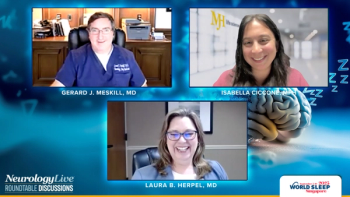
- December 2021
- Volume 4
- Issue 7
Serotonin Receptor Agonism in Dravet Syndrome
As Dravet syndrome is often nonresponsive to existing therapeutics, it can be a challenge to treat, and this refractory nature creates a great need for novel, innovative, and safe antiepileptic drugs for its treatment.
DRAVET SYNDROME (DS) IS A rare form of childhood-onset epilepsy that affects approximately 1 in 30,000 people worldwide.1–5 DS significantly impacts individuals throughout their lifetime and increases the risk of Sudden Unexpected Death in Epilepsy.1-3 DS seizures are often febrile and prolonged, generalized or unilateral, and clonic or tonic-clonic.4,6 These prolonged seizures, which begin in infancy,4,6 eventually contribute to developmental delays, cognitive and behavioral impairments, impaired quality of life, and increased mortality.2,7 DS is particularly difficult to treat because it is often drug resistant (refractory).4 DS is often nonresponsive to currently approved antiepileptic drugs (AEDs).1-3 There is thus a need for novel, innovative, and safe AEDs for DS.7
DS is a heterogeneous disease that can arise from de novo mutations of genes involved in neurotransmission.1,6 Approximately 70% to 80% of patients with DS carry de novo mutations in SCN1A, which encodes a neural voltage-gated sodium channel and is the most clinically relevant epilepsy gene.1,4,6 The underlying etiology of epilepsy is an imbalance of central inhibitory (eg, γ-aminobutyric acid; GABA) vs excitatory (eg, glutamate) neurotransmission in the forebrain (Figure).4,6,8 Prolonged seizures that manifest during childhood are associated with a decrease in GABAA receptor activity and a resulting increase in glutamatergic N-methyl-D-aspartate (NMDA) receptor activity.4,8 In refractory forms of epilepsy such as DS, this NMDA receptor stimulation is deregulated and causes aberrant, unchecked excitatory activity leading to seizures.8 In clinical trials, NMDA receptor antagonists have shown activity in mitigating epilepsy in children and adults; however, their significant adverse effects (AEs) have severely limited their continued use.8
Many drugs that elevate brain extracellular 5-HT levels, such as serotonin (5-hydroxytryptamine; 5-HT) reuptake inhibitors, exhibit antiepileptic effects.9 Specifically, an increase in 5-HT tone is associated with an increased seizure threshold and/or antiepileptic activity, whereas a decrease in 5-HT is associated with a reduced seizure threshold.9 Found in the central and peripheral nervous systems, 5-HT receptors (5-HTRs) are G protein–coupled receptors and ligand-gated ion channels.1 Fourteen subtypes of 5-HTRs are currently known, with strong evidence that the 5-HT2CR subtype is involved in seizures.3,9 Among the 5-HTRs, 5-HT2CR is a particularly attractive therapeutic target because its expression is restricted to the central nervous system (CNS).7
Preclinical investigations in animal models have validated the efficacy of proprietary 5-HT2CR–targeting therapeutic compounds for DS.10 Animal models are fast, cost-efficient tools for AED screening.1,4 Important for this approach, all 14 known human 5-HTR subtypes have orthologues in zebrafish, an important model organism for DS research.4 Mutant mice lacking 5-HT2CR experience spontaneous tonic-clonic seizures and a decreased seizure threshold.7,9 Conversely, agonists (stimulants) of 5-HT2CR provide protection against convulsive seizures.9 In humans, reduced levels of 5-HT in the brain similarly result in spontaneous seizures, premature death, and greater sensitivity to convulsants.1
As a result of their global effects on 5-HTRs and other signaling proteins, 5-HTR–targeting AEDs exhibit overwhelmingly harmful off-target effects, which preclude their use in treating DS.9 5-HT2AR and 5-HT2CR heteroreceptor complexes are targets for novel anti-absence drugs.9 Agonists of 5-HT2AR, it should be noted, may be hallucinogenic in humans.9 Moreover, some 5-HT2CR agonists have been shown to increase seizure length, rather than prevent seizures.9 Some studies suggest that 5-HT2BR is the primary target of DS therapeutics currently in clinical development.1 Overall, there is controversy regarding whether modifying signaling through 5-HTRs (either through agonism or antagonism) can achieve anticonvulsant activity.1,4,8 Investigators are endeavoring to resolve the precise mechanism through which 5-HT is associated with seizure susceptibility; identification of the specific receptors that mediate the effects of 5-HTR-targeting therapies would help guide drug development in this area.1 Of particular importance is understanding which receptors are targeted by each therapeutic because modulating certain receptors’ function (ie, 5-HT2BR) can cause severe AEs.1,3
One 5-HTR–activating drug under investigation is fenfluramine (Fintepla; Zogenix11).3,4 Fenfluramine is a racemic mixture of 2 enantiomers, which are metabolized in vivo into compounds with different degrees of affinity for fenfluramine’s targets in the 5-HTR family: 5-HT2AR, 5-HT2BR, and 5 HT2CR.8 Fenfluramine functions by stimulating 5-HT release in the brain.3,4 Coadministration of fenfluramine with phentermine was once commonly prescribed to promote weight loss in obese patients, but this was found to have significant cardiac AEs—valvulopathy and pulmonary hypertension—possibly due to its effects on 5-HT2BR.4,6,12
Fenfluramine exhibits antiepileptic properties and thus diminishes epileptiform discharges in experimental animal models of DS.8 Fenfluramine is a selective agonist of the receptors— 5-HT1DR, 5-HT2AR, 5-HT2BR, and 5-HT2CR—that mediate seizure risk in animal models.2-4,6,8 In a preclinical zebrafish study, prolonged use of fenfluramine correlated with increased neurogenesis and stabilized interneuron activity (FIGURE).4,6,8 In a small, open-label trial (add-on treatment), fenfluramine demonstrated a significant reduction in seizures in children with DS7; 70% of the patients remained seizure free for more than 1 year.4 ZX008, a low-dose fenfluramine, has been granted orphan drug designation for DS by the FDA.8 Phase 3 clinical trials (NCT0335520913) with ZX008 are currently ongoing worldwide, with expected completion in March 2024.8,13
Lorcaserin (Belviq; Eisai14) is another 5-HTR agonist that is being tested for use as a DS treatment.7,12 Lorcaserin was previously marketed as an appetite suppressant.12 In February 2020, Eisai voluntarily withdrew this drug and discontinued sales in the United States due to findings from a safety clinical trial that showed possible increased occurrence of cancer.15 Lorcaserin is selective for 5-HT2CR, which may minimize its safety liabilities compared with drugs, such as fenfluramine, that more broadly target the serotonergic system.7 In a preclinical zebrafish model, lorcaserin reduced seizures.7 In a small-scale study in humans, lorcaserin was used to treat 5 patients with medically intractable DS.16 Seizure frequency was successfully reduced by 65% during the first 3-month treatment period.16
The phase 3 MOMENTUM 1 clinical study (NCT0457224317), which is expected to be completed by May 2023, is evaluating lorcaserin in patients with DS.17 MOMENTUM 1 has a target enrollment of 58 patients with DS at 25 sites in the United States and 5 in Canada.17 Subjects must be 2 years or older, have a diagnosis of epilepsy with DS, had at least 4 convulsive seizures during the 4-week period before baseline, and currently be on an AED treatment regimen that is stable for at least 4 weeks before screening and is expected to remain stable throughout the study.17 Exclusion criteria include patients who received lorcaserin or fenfluramine within 4 weeks or 2 months before screening, respectively, have recent or concomitant use of serotonergic medications or monoamine oxidase inhibitors, or currently have progressive CNS disease other than DS.17 Patients receive oral lorcaserin or placebo twice daily for 14 weeks at 1 of 3 dosages according to body weight.17 The primary end point, the percent change from baseline in the number of convulsive seizures per 28 days, will be compared between the lorcaserin and placebo groups.17 A secondary end point is the percentage of patients with a 50% or greater reduction in the frequency of convulsive seizures per 28 days in the core treatment period compared with baseline.17 A major goal of MOMENTUM 1 is to characterize the pharmacokinetics of lorcaserin and the relationships between lorcaserin plasma concentrations and efficacy and safety.17,18 MOMENTUM 2 (NCT0445768719) is an ongoing lorcaserin expanded access program for patients who have completed the MOMENTUM 1 trial or who have refractory epilepsy currently treated with lorcaserin, which was initiated prior to its market withdrawal in February 2020.18,19 Patients must experience clinical benefit from lorcaserin use, as determined by their treating physician.19
Novel 5-HT2CR agonists for DS are under development to improve selectivity for 5-HT2CR over other 5-HTR subtypes.4,9,10 Bright Minds Biosciences released preclinical data in August 2021 on their proprietary 5-HT2CR agonist BMB-101.10 BMB-101 showed efficacy against DS-like symptoms in 2 preclinical rodent models (mouse 6-Hz psychomotor seizure model and rat maximum electroshock seizure model) and a zebrafish model (scn1Lab). Lower seizure duration and frequency was observed in the mice, and the zebrafish had reductions in locomotor activity and cumulative duration of epileptiform events in the brain.10 In the zebrafish model, BMB-101 diminished abnormal brain activity to prevent seizures.4,10 The rat model demonstrated meaningful protection against generalized seizures in a dose-dependent manner.10 BMB-101 exhibited effects similar to those of other AEDs, such as fenfluramine.10
Large-scale drug discovery and development should continue leading to improved seizure control outcomes and potentially even reversal of neurodevelopmental defects in patients with DS.1,2 For instance, fenfluramine has been determined to do more than just promote 5-HT release.2 Fenfluramine can also positively modulate activity at sigma-1 receptors (Sigma1Rs), which may play a secondary role in this drug’s antiseizure activity (FIGURE).2,4,6,8 Additionally, Sigma1Rs may mediate nonseizure comorbidities in the pathophysiology of developmental and epileptic encephalopathies such as DS.2 Sigma1R is a chaperone protein with diverse functions in maintaining calcium homeostasis in the cell.2 Similar to 5-HTRs, Sigma1Rs in the brain function to regulate neuronal responses by maintaining the balance between excitatory and inhibitory circuits in neurons and glial cells.2 The excitatory/ inhibitory neuronal imbalance that leads to seizures can trigger Sigma1R activation. Sigma1R is thus a potential novel target for treating seizure-related disorders such as DS.2 Fenfluramine may positively impact cognition through a Sigma1R related mechanism.2 The combined effect of fenfluramine on 5-HTRs and Sigma1Rs may thus be effective in promoting antiseizure activity while improving cognitive function in patients with DS.2
For correspondence: [email protected]
New York Genome Center, New York, NY
REFERENCES
1. Griffin AL, Jaishankar P, Grandjean JM, Olson SH, Renslo AR, Baraban SC. Zebrafish studies identify serotonin receptors mediating antiepileptic activity in Dravet syndrome. Brain Commun. 2019;1(1). doi:10.1093/braincomms/fcz008
2. Martin P, Reeder T, Sourbron J, de Witte PAM, Gammaitoni AR, Galer BS. An Emerging Role for Sigma-1 Receptors in the Treatment of Developmental and Epileptic Encephalopathies. Int J Mol Sci. 2021;22(16):8416. doi:10.3390/ijms22168416
3. Silenieks LB, Carroll NK, Van Niekerk A, et al. Evaluation of Selective 5-HT2C Agonists in Acute Seizure Models. ACS Chem Neurosci. 2019;10(7):3284-3295. doi:10.1021/acschemneuro.8b00739
4. Sourbron J, Schneider H, Kecskés A, et al. Serotonergic Modulation as Effective Treatment for Dravet Syndrome in a Zebrafish Mutant Model. ACS Chem Neurosci. 2016;7(5):588-598. doi:10.1021/acschemneuro.5b00342
5. Dravet Syndrome. Epilepsy Foundation. Accessed October 31, 2021. https://www.epilepsy.com/learn/types-epilepsy-syndromes/dravet-syndrome
6. Tiraboschi E, Martina S, van der Ent W, et al. New insights into the early mechanisms of epileptogenesis in a zebrafish model of Dravet syndrome. Epilepsia. 2020;61(3):549-560. doi:10.1111/epi.16456
7. Tolete P, Knupp K, Karlovich M, et al. Lorcaserin therapy for severe epilepsy of childhood onset: A case series. Neurology. 2018;91(18):837-839. doi:10.1212/WNL.0000000000006432
8. Rodríguez-Muñoz M, Sánchez-Blázquez P, Garzón J. Fenfluramine diminishes NMDA receptor-mediated seizures via its mixed activity at serotonin 5HT2A and type 1 sigma receptors. Oncotarget. 2018;9(34):23373-23389. doi:10.18632/oncotarget.25169
9. Venzi M, David F, Bellet J, et al. Role for serotonin2A (5-HT2A) and 2C (5-HT2C) receptors in experimental absence seizures. Neuropharmacology. 2016;108:292-304. doi:10.1016/j.neuropharm.2016.04.016
10. Biosciences BM. Bright Minds Biosciences (“BMB”) Proprietary 5-HT2C Agonist Shows Significant Reduction in Seizure Activity. GlobeNewswire News Room. Published August 18, 2021. Accessed October 11, 2021. https://www.globenewswire.com/en/news-release/2021/08/18/2282587/0/en/Bright-Minds-Biosciences-BMB-Proprietary-5-HT2C-Agonist-Shows-Significant-Reduction-in-Seizure-Activity.html
11. FINTEPLA® (fenfluramine) oral solution, CIV | For Dravet Syndrome Seizures. Accessed October 11, 2021. https://www.fintepla.com
12. Bohula EA, Wiviott SD, McGuire DK, et al. Cardiovascular Safety of Lorcaserin in Overweight or Obese Patients. N Engl J Med. 2018;379(12):1107-1117. doi:10.1056/NEJMoa1808721
13. Zogenix International Limited, Inc., a subsidiary of Zogenix, Inc. A Two-Part Study of ZX008 in Children and Adults With Lennox-Gastaut Syndrome (LGS); Part 1: A Randomized, Double-Blind, Placebo-Controlled Trial of Two Fixed Doses of ZX008 (Fenfluramine Hydrochloride) Oral Solution as Adjunctive Therapy for Seizures in Children and Adults With LGS, Followed by Part 2: An Open-Label Extension to Assess Long-Term Safety of ZX008 in Children and Adults With LGS. clinicaltrials.gov; 2021. Accessed October 31, 2021. https://clinicaltrials.gov/ct2/show/NCT03355209
14. FDA requests the withdrawal of the weight-loss drug Belviq, Belviq XR (lorcaserin) from the market. FDA. Published online February 13, 2020. Accessed October 11, 2021. https://www.fda.gov/drugs/drug-safety-and-availability/fda-requests-withdrawal-weight-loss-drug-belviq-belviq-xr-lorcaserin-market
15. Eisai to Voluntarily Withdraw BELVIQ®/BELVIQ XR® in the U.S. Eisai Newsroom. Accessed November 1, 2021. https://eisai.mediaroom.com/2020-02-13-Eisai-to-Voluntarily-Withdraw-BELVIQ-R-BELVIQ-XR-R-in-the-U-S
16. Griffin A, Hamling KR, Hong S, Anvar M, Lee LP, Baraban SC. Preclinical Animal Models for Dravet Syndrome: Seizure Phenotypes, Comorbidities and Drug Screening. Front Pharmacol. 2018;9:573. doi:10.3389/fphar.2018.00573
17. Eisai Inc. A Multicenter, Double-Blind, Randomized, Placebo-Controlled, Parallel-Group Study With Open-Label Extension Phase of Lorcaserin as Adjunctive Treatment in Subjects With Dravet Syndrome. clinicaltrials.gov; 2021. Accessed October 10, 2021. https://clinicaltrials.gov/ct2/show/NCT04572243
18. Eisai Initiates Phase 3 MOMENTUM 1 Clinical Trial (Study 304) of Lorcaserin in Dravet Syndrome. Eisai Newsroom. Accessed November 1, 2021. https://eisai.mediaroom.com/2020-09-30-Eisai-Initiates-Phase-3-MOMENTUM-1-Clinical-Trial-Study-304-of-Lorcaserin-in-Dravet-Syndrome
19. Eisai Inc. Extended Access Program and Retrospective Chart Review for Lorcaserin in Dravet Syndrome and Other Refractory Epilepsies. clinicaltrials.gov; 2021. Accessed October 5, 2021. https://clinicaltrials.gov/ct2/show/NCT04457687
Articles in this issue
almost 4 years ago
Cluster Headache: A Clinical Overviewalmost 4 years ago
A Practical Approach to Chronic Immunosuppression in Myasthenia Gravisalmost 4 years ago
Managing and Treating Neuromyelitis Optica Spectrum Disorderalmost 4 years ago
An Emerging Framework for Parkinson Disease TherapeuticsNewsletter
Keep your finger on the pulse of neurology—subscribe to NeurologyLive for expert interviews, new data, and breakthrough treatment updates.



































